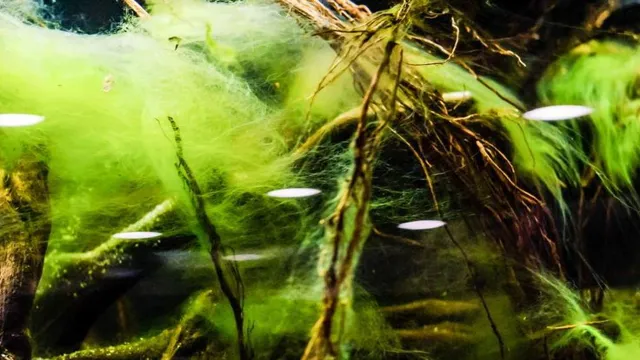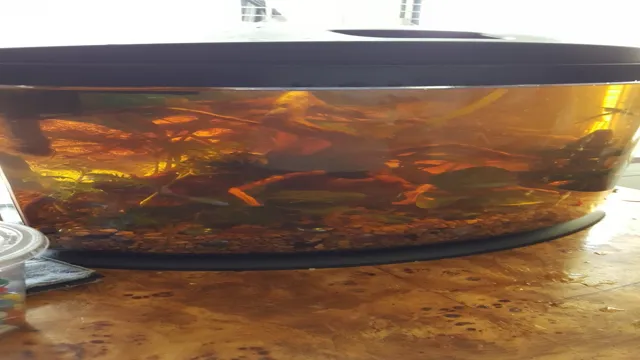Do you love keeping fish in your home aquarium? Do you want your fish to live happily and healthily? Then, you need to ensure that the air pump in your aquarium is dampened. In this blog, we will guide you on how to dampen your aquarium air pump and keep your fish happy. An air pump in your aquarium is essential if you want to maintain a healthy environment for your fish.
It helps to circulate the water, oxygenate it, and keep the water moving. However, the sound of the air pump can be distracting, especially if your aquarium is located in your bedroom or living room. The sound can disturb your peace and make it difficult to sleep or work.
Moreover, if you have a large aquarium, the sound of the air pump can be very loud, similar to a vacuum cleaner. This can be stressful for your fish, leading to health problems that can be fatal. To avoid this, you need to learn how to dampen your aquarium air pump to reduce noise levels and prevent stress for your fish.
The process of dampening your aquarium air pump is simple. It involves using specific materials like foam, rubber, or silicone to mute the sound of the air pump. You can also use a muffler or a noise reduction device to achieve this.
However, you need to be careful not to compromise the function of the air pump while dampening it. In summary, learning how to dampen your aquarium air pump is crucial for maintaining a peaceful and healthy environment for your fish. It is a simple process that can be achieved with different materials or noise reduction devices.
Follow our guide, and your fish will thank you.
Understanding the Importance of Dampening
If you’re looking to create a serene and peaceful environment for your aquarium, it’s essential to understand the importance of dampening your aquarium air pump. When air is pushed through the pump, it can create a noisy and disruptive environment for your aquatic pets, which can cause stress and agitation. On top of that, the bubbles produced by the pump can be too strong and create a current that disturbs the water’s surface.
By dampening your air pump, you can minimize the noise and turbulence to create a more relaxing and comfortable atmosphere for your aquatic friends. So, how do you dampen your aquarium air pump? One way is to attach a piece of airline tubing to the air pump’s output, which will help absorb some of the vibration. You can also place the pump on a soft, vibration-resistant material such as a sponge.
By taking these small steps, you can create a peaceful and healthy environment for your aquarium pets.
Reducing Unwanted Noise
Reducing unwanted noise is crucial for maintaining a peaceful environment. One effective way of achieving this is through understanding the importance of dampening. Dampening is the process of reducing or eliminating unwanted sound vibrations by absorbing or scattering the sound waves.
This can be done through the use of sound-absorbing panels, acoustic insulation materials, or even furniture. Dampening is particularly important in areas such as offices, music studios, and homes located in noisy neighborhoods. Without effective dampening, sound waves can bounce off surfaces and create echoes, making it difficult to concentrate or relax.
By investing in proper dampening materials, you can create a more conducive environment that enhances productivity and well-being. So, consider making dampening a priority in your space and enjoy the benefits of a quieter, more peaceful environment.

Preventing Vibrations and Prolonging the Life of Your Pump
As a pump operates, it can generate significant vibrations that can cause wear and tear over time, shortening its lifespan or even causing it to fail completely. That’s why it’s essential to understand the importance of dampening. Dampening is the process of reducing or eliminating the effects of vibrations, and it can be achieved in various ways.
One method is using a rubber mount or pad under the pump to absorb the vibrations. Rubber is an efficient material for dampening since it is flexible and can absorb a significant amount of energy. Additionally, using shock absorbers or vibration isolators can reduce the impact of vibrations, preventing them from propagating throughout the pump and causing damage.
By implementing dampening techniques, you can significantly improve your pump’s lifespan, reducing the need for frequent repairs or replacement. Remember that taking preventative measures such as dampening not only saves money in the long term but also prevents disruptions and downtime for your operations. Don’t wait until your pump fails – start implementing dampening techniques today.
Materials You Will Need
If you’re bothered by the loud buzzing noise of your aquarium air pump, you may want to consider dampening the sound. You only need a few materials to do so: a foam block that is big enough to fit your air pump, a sharp knife or scissors, and some zip ties. First, measure the dimensions of your air pump and cut the foam block accordingly. (See Also: How to Get Rid of Yellow Water in Aquarium: Effective Tips and Tricks)
Make a hole in the foam to fit the air tube and power cord. Encase the air pump inside the foam block and secure it with zip ties, being mindful not to block any air vents. The foam will help absorb the sound waves produced by the air pump, therefore, reducing the noise.
Not only will this create a more peaceful environment for you and your fish, but it will also make it easier to sleep through the night without the annoying hum in the background. Overall, dampening an aquarium air pump is a simple and cost-effective way to enjoy fish-keeping without any unnecessary noise disturbances.
Aquarium Airline Tubing
Aquarium airline tubing is an essential component that helps your fish tank thrive. To ensure that your aquarium is supplied with enough air, you will need some essential materials. Firstly, getting high-quality aquarium airline tubing is crucial.
This pliable, transparent tubing is designed for use with aquarium equipment, such as air stones and air pumps. It’s important to get tubing specifically for aquarium use to ensure that there are no harmful chemicals leaching into the water, which could harm your fish. Additionally, you’ll need suction cups to appropriately secure the airline tubing in place, so it doesn’t move and disrupt the water flow.
Lastly, an air pump is necessary for supplying adequate air to your fish tank. Without an air pump, the aquarium water will become stagnant and cause various problems such as algae growth and bacterial infection. So, make sure to get the right equipment to keep your aquarium healthy and thriving.
Check Valve
A check valve is an essential tool in any pumping system, and it’s crucial to have the proper materials to install or replace it. Firstly, you’ll need the right type and size of the valve, depending on the application and fluid being pumped. Secondly, you’ll need pipe fittings to connect the valve to the pipeline.
The fittings should match the valve’s material and size to avoid leaking or damage. Thirdly, sealants like Teflon tape or pipe dope are necessary to prevent any leaks or air gaps between the valve and the pipeline. Lastly, you’ll need a pipe wrench or adjustable wrench to tighten the fittings and valve to prevent any loosening over time.
Overall, using the correct materials is vital in ensuring that the check valve functions correctly and efficiently, preventing leaks and potential system failure due to improper installation or maintenance.
Air Stone or Diffuser
When setting up an aquarium, one important decision is whether to use an air stone or a diffuser for aeration. Both serve the same purpose of increasing oxygen levels in the tank for the health of your aquatic pets and the overall ecosystem. However, the main difference is in how they distribute the air.
Air stones release small bubbles which rise to the surface, creating a stream of oxygen as they pop. Diffusers, on the other hand, diffuse air through a porous membrane which produces tiny bubbles that diffuse throughout the tank. To set up either option, you will need an air pump, tubing, and the chosen aeration tool.
With an air stone, simply connect the tubing to the air pump and attach the stone to the end of the tube. For a diffuser, connect the tube to the air pump and insert the diffuser into the tank. Ultimately, the choice between an air stone and diffuser may come down to personal preference or the needs of the specific aquarium setup.
A Muffler or Silencer
If you’re looking to install a muffler or silencer, there are a few materials you’ll need to get started. First and foremost, you’ll need the muffler or silencer itself. There are many different types and sizes available, so be sure to choose one that fits your specific vehicle and needs.
You’ll also need exhaust clamps or hangers to secure the muffler in place. Other materials that may come in handy include exhaust pipe, a saw or cutting tool to trim the pipe to size, and welding equipment if you need to make any modifications to the exhaust system. It’s important to note that installing a muffler or silencer can be a bit challenging, especially if you’re not familiar with car maintenance.
If you’re unsure about how to proceed, it’s always best to consult a professional for help. With the right tools and guidance, however, you can easily install a muffler or silencer and enjoy a quieter ride. (See Also: How to Activate Aquarium Portal Subnautica: Step-by-Step Guide for Seamless Exploration)
Step-by-step Guide to Dampening Your Aquarium Air Pump
If you’re a fish enthusiast, then you’ll know that keeping an aquarium can be an exciting and rewarding hobby. One key component of maintaining a healthy aquarium environment is an air pump, which helps to oxygenate the water and create bubbles that aid in filtering. However, air pumps can also be quite noisy, and the constant humming can be distracting and irritating.
Thankfully, you can dampen your aquarium air pump to reduce noise levels and improve your aquarium experience. All you need is some sponge, rubber bands, and a pair of scissors. Simply cut the sponge into small pieces to fit over the air pump, then secure it in place with rubber bands.
This will help to absorb the vibrations, reducing the noise. It’s that easy! By dampening your aquarium air pump, you and your beloved fish can enjoy a quieter and more peaceful aquatic environment.
Step 1: Disconnect Your Air Pump
Aquarium air pump If you want to dampen your aquarium air pump, the first step is to disconnect it. This is important since the pump needs to be isolated from any other devices for the process to be successful. To do this, switch off your aquarium air pump and unplug it from the power outlet.
Make sure that the tubing from the air pump is disconnected from the air stone or air diffuser in the aquarium as well. Once you have done that, you can then move on to the next step of the process. It is essential to ensure that you disconnect all the parts to avoid any accidental damage to the equipment.
By following the first step, you are on your way to a peaceful and quiet aquarium.
Step 2: Attach the Check Valve and the Muffler to the Airline Tubing
In the second step of dampening your aquarium air pump, you need to attach the check valve and muffler to the airline tubing. A check valve is important because it prevents water from flowing back into the air pump, which could damage it or cause it to malfunction. The muffler, on the other hand, helps to reduce the noise produced by the air pump, which can be very annoying if you have to listen to it for long periods of time.
Attaching the check valve and muffler is relatively simple. First, take the airline tubing and insert one end into the check valve. The other end of the check valve should then be attached to the air stone or other aquarium accessory that you are using.
Make sure that the check valve is installed in the right direction – there should be an arrow on the valve that indicates the flow of air. Next, attach the muffler to the other end of the airline tubing. The muffler should simply slide onto the tubing and be secured in place with a clamp or zip tie.
Once everything is securely attached, turn on the air pump and check to make sure that everything is working properly. You should notice a reduction in noise immediately, and the check valve will ensure that the air pump is working efficiently without risk of backflow. Overall, attaching the check valve and muffler is a quick and easy way to dampen your aquarium air pump and create a more peaceful and enjoyable environment for both you and your fish.
By taking the time to do this simple step, you can enjoy the benefits of an air pump without the common downsides of noise and potential damage.
Step 3: Add the Air Stone or Diffuser
Adding an air stone or diffuser to your aquarium is an essential step in dampening your aquarium air pump. The air stone or diffuser is responsible for distributing air evenly throughout your aquarium, which helps to oxygenate the water and promote a healthy aquatic environment. To add the air stone, simply attach it to the end of your air tubing and place it at the bottom of your aquarium.
If you are using a diffuser, attach it to your air pump and then place it at the bottom of your aquarium. The air stone or diffuser works by breaking up the air bubbles, which creates smaller, gentler bubbles that don’t create too much noise or vibration. This not only dampens the sound but also prevents any damage to your fish or plants.
By including an air stone or diffuser in your aquarium setup, you can ensure a quiet, peaceful, and healthy environment for your aquatic pets.
Step 4: Reconnect Your Air Pump and Test the Noise Levels
If you’ve successfully completed the previous steps, it’s time to reconnect your air pump and test the noise levels. Before turning on the air pump, make sure that the tubing is attached securely to both the pump and the air stone or air-powered ornament. Once everything is connected, plug in the air pump and listen for any unusual noises. (See Also: How to Grow Moss on Aquarium Wall: Tips and Tricks for a Natural Aquatic Landscape)
Ideally, your air pump should be audible but not obnoxiously loud. If you’re still experiencing excessive noise levels, check to ensure that the air pump is positioned on a level surface and not vibrating against any surfaces. If necessary, try using rubber feet or a foam pad under the air pump to absorb any vibrations.
If you find that the noise level is still too high, consider adding a muffler or swapping out your air pump for a quieter model. Overall, dampening the noise of your aquarium air pump will not only improve your own experience, but also create a more peaceful and stress-free environment for your aquatic pets.
Conclusion
So there you have it, folks – three foolproof methods for dampening the noise of your aquarium air pump. Whether you go for the trusty sponge technique, the stealthy soundproofing material, or the creative and quirky plant solution, your fishy friends will thank you for the peace and quiet. And who knows, with all that extra silence in the room, you might even hear the sound of their contented little glub-glubs.
“
FAQs
Why is it important to dampen aquarium air pump?
It is important to dampen aquarium air pump because it reduces the noise level and vibration from the air pump, which can stress out the fish and affect their health.
What materials can be used to dampen aquarium air pump?
Materials such as foam, rubber, or silicone can be used to dampen aquarium air pump. These materials absorb the vibration and sound from the air pump, making it quieter and more stable.
How do you install a dampening material on aquarium air pump?
To install a dampening material on an aquarium air pump, cut the material to size and wrap it around the pump. Use tape or adhesive to secure the material in place, ensuring that the pump is fully covered.
Can all aquarium air pumps be dampened?
Most aquarium air pumps can be dampened, but it is important to check the manufacturer’s instructions before doing so. Some pumps may require special care or may not be compatible with certain dampening materials.
What are the benefits of using a dampened aquarium air pump?
Using a dampened aquarium air pump reduces the noise level and vibration of the pump, making it more pleasant for the fish and the owner. It also helps the pump to last longer by reducing wear and tear.
How do you know if your aquarium air pump needs to be dampened?
If your aquarium air pump is making a loud, vibrating noise, it may need to be dampened. You can also observe the fish to see if they seem stressed or agitated, which can be a sign of excessive noise or vibration.
Can a dampened aquarium air pump affect the water quality in the tank?
A dampened aquarium air pump does not typically affect the water quality in the tank. However, it is important to ensure that the materials used to dampen the pump are non-toxic and do not leach into the water.







